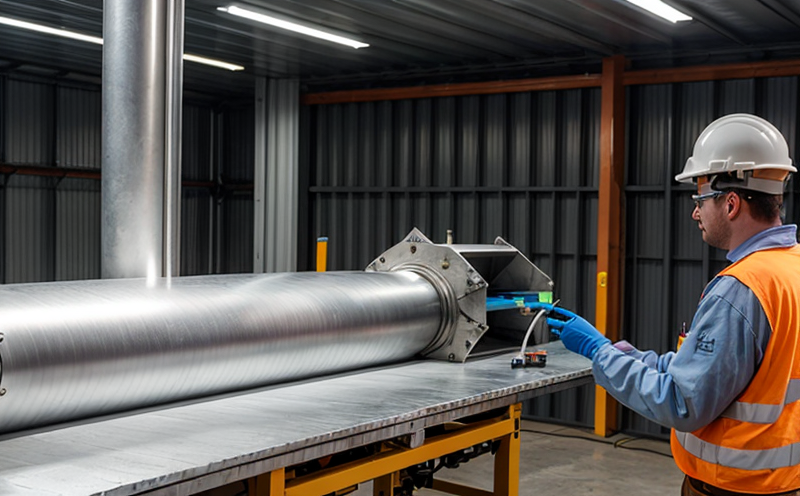ASTM E23 Charpy Impact Testing of Renewable Energy Alloys
The ASTM E23 standard specifies methods for conducting Charpy impact testing on materials to determine their toughness and ductility. This test is crucial in the evaluation of alloys used in renewable energy applications, where materials must withstand extreme environmental conditions such as high temperatures, corrosion, and mechanical stress.
Materials like stainless steel, nickel-based superalloys, and titanium are often used in components such as turbines, blades, and casings for wind and tidal power generation. These components operate under challenging environments that can lead to brittle fracture or fatigue failure if the materials do not possess sufficient impact toughness. The ASTM E23 Charpy V-notch test provides a standardized method to assess these critical properties.
The testing procedure involves subjecting a U-shaped or V-shaped notch specimen to an impact load, which measures how much energy can be absorbed before fracture occurs. This is particularly important for renewable energy applications where materials must withstand not only the physical stresses of operation but also the environmental stressors such as salt spray and high humidity.
Using this test helps manufacturers ensure that their components meet stringent quality standards. It allows them to optimize material selection, improve product design, and enhance reliability in harsh conditions. This is especially critical for renewable energy systems where downtime can be costly and have significant environmental impacts.
The Charpy impact testing process is highly precise and reproducible, making it a vital tool in the development of new alloys for renewable applications. By adhering to ASTM E23 standards, laboratories ensure that their results are reliable and internationally comparable, which is essential for global compliance and market access.
- Enhances product reliability under harsh environmental conditions
- Supports compliance with international regulatory requirements
- Facilitates the optimization of material properties for specific applications
- Aids in the development of innovative alloys that meet industry standards
- Maintains consistency across production batches to ensure quality control
- Improves the overall lifecycle performance and durability of renewable energy components
ASTM E23 Charpy impact testing is a cornerstone of ensuring the robustness of materials used in renewable energy systems. By providing accurate, repeatable data on material toughness, this test supports the continuous improvement of technology that powers our sustainable future.
Why It Matters
The significance of ASTM E23 Charpy impact testing lies in its ability to predict the behavior of materials under dynamic loading conditions. This is particularly important for renewable energy applications where components are exposed to a wide range of environmental and operational stresses.
In wind turbines, for example, the blades must withstand high-speed winds, extreme temperatures, and periodic mechanical loads. The Charpy test helps ensure that the material used in these blades can absorb significant impact energy without fracturing, thereby enhancing safety and longevity. Similarly, in tidal power systems, materials need to resist harsh saltwater environments while withstanding repeated mechanical stresses.
The results of this testing are critical for several stakeholders:
- Manufacturers can refine their processes to produce more reliable products
- Regulatory bodies gain assurance that the components meet safety and performance standards
- R&D teams have data to inform ongoing innovation in materials science
- Purchasers and operators of renewable energy systems can make informed decisions about component procurement and maintenance schedules
The Charpy impact test is not just a compliance requirement; it represents an investment in the reliability and safety of renewable energy technologies. By ensuring that materials are tough enough to withstand real-world conditions, this testing process contributes significantly to the overall performance and longevity of renewable systems.
Benefits
International Acceptance and Recognition
The ASTM E23 Charpy impact test is widely recognized and accepted across the globe for its reliability and precision. It has been adopted by numerous international standards organizations including ISO, EN, IEC, and others.
This standard provides a common language and methodology that ensures consistency in testing procedures and results worldwide. Laboratories that perform ASTM E23 tests are able to provide data that is universally understood and accepted, which is critical for global projects and collaborations.
The international acceptance of this test means that materials tested according to ASTM standards can be used with confidence across different regions and industries. This fosters a collaborative environment where knowledge and innovation can flow freely between countries and companies.
For example, wind turbine manufacturers in Europe might use ASTM E23 data for compliance purposes, while suppliers of materials may rely on the same test results to ensure their products meet international standards. The standard's global recognition simplifies regulatory processes and enhances market access for renewable energy technologies.
The acceptance of ASTM E23 is not just about compliance; it represents a commitment to quality and reliability that benefits all stakeholders in the renewable energy sector.





